Naples is a city with a mysterious charm that offers a plethora of underground tunnels and routes to discover. Many guided tours allow you to explore Neapolitan tunnels. In this article, I tell you about the Bourbon Tunnel, an underground route excavated by hand in tuff, commissioned by King Ferdinand II of Bourbon. The tour is highly fascinating as it takes you through the city, passing through air-raid shelters and warehouses filled with cars seized after the war.
Table of Contents
About the Bourbon Tunnel in Naples
The Bourbon Tunnel is a 431-meter-long tunnel, entirely dug by hand. King Ferdinand II of Bourbon commissioned it as a quick escape route from the Royal Palace to the sea. The original plan was two tunnels, one for carriages and the other for pedestrians, both lit by gas. However, the Bourbon Tunnel was never completed as planned. It encountered numerous variants during construction before being suspended for economic reasons. Eventually, work stopped after the political change due to the Unification of Italy.
ORGANISE YOUR TRIP TO NAPLES
Save money on your trip to Naples with the Naples Pass and enjoy access to popular attractions like the underground city tour and the Catacombs of San Gennaro, along with unlimited public transport.
Stay connected throughout Italy by getting an Airalo eSim online for reliable data and phone coverage. Don’t forget to secure your Heymondo travel insurance for peace of mind and be covered for any surprises on your adventure!
What remained of the Bourbons’ ambitious engineering work was converted into an air raid shelter during World War II. The shelter provided refuge to Neapolitan citizens during Allied and German bombing raids. The Bourbon Tunnel air-raid shelters housed around 5,000 and 10,000 Neapolitans.
After the war, until 1970, the Bourbon Tunnel was used as a Municipal Court Depot for seized motorbikes and cars and to store everything extracted from the rubble of the bombings. Until some years ago, the underground areas were completely filled in.
Today, the Bourbon Tunnel was rediscovered thanks to the work of Associazione Culturale Borbonica Sotterranea (Bourbon Underground Cultural Association). Its underground route through the city via ancient cisterns and tuff quarries is accessible for guided tours and events organised by the association, which oversaw its restoration after its rediscovery and excavation.
Bourbon Tunnel routes open to the public
The Naples Underground offers various itineraries for visitors to discover between the Naples Underground and the Catacombs. The Bourbon Tunnel offers multiple tours managed by the Bourbon Underground Cultural Association. Alongside the Standard Route and the Via delle Memorie route are the Adventure Route and the Speleo Light Route, more adventurous guided tours through narrow tunnels with torch, harness and helmet.
In this article, I tell you about the Via delle Memorie route because, together with the Standard Route, it is the most suitable for everyone, despite a long walk in the Neapolitan underground. The Via delle Memorie tour is very similar to the Standard Route. Still, it focuses mainly on the history of Naples rather than on Bourbon engineering.
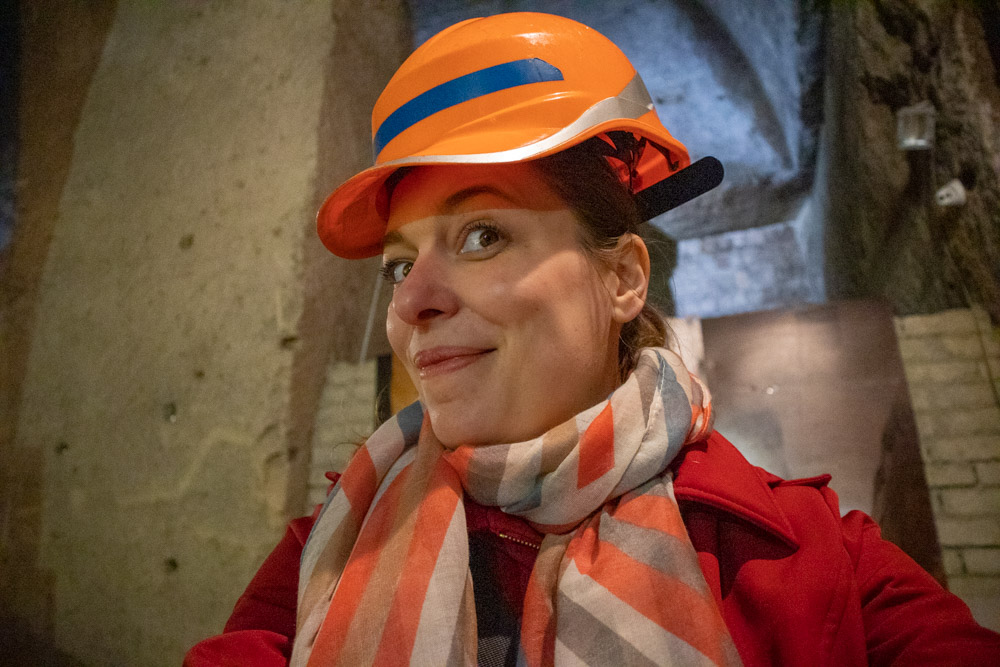
The Bourbon Tunnel’s Via delle Memorie route
The Via delle Memorie route of the Bourbon Tunnel begins at Palazzo Serra di Cassano, an impressive monumental building with an intriguing history. The tour takes you underground in Naples, passing through a World War II air-raid shelter and a series of cisterns before concluding at a judicial depot for impounded cars and motorbikes that demonstrate the ingenuity of the Neapolitan people.
Palazzo Serra di Cassano
The Bourbon Tunnel Via delle Memorie itinerary begins at Palazzo Serra di Cassano, an aristocratic building in the city centre. This building houses the Italian Institute for Philosophical Studies and its library.
Before descending into the Neapolitan underground, the guide explains what makes the architecture of this building so unique, particularly the palace rooms decorated with rococo stuccoes, frescoes, paintings and neoclassical furniture. Nevertheless, these rooms are open only during public events.
Access to Palazzo Serra di Cassano has always been through the back of the building rather than through the main door facing the Royal Palace of Naples. This main door has remained closed for centuries as a rejection of the king due to the execution of Gennaro Serra di Cassano, son of Duke Luigi Serra di Cassano and Giulia Carafa, who was condemned and beheaded for taking part in the revolution of the Neapolitan Republic in 1799.
From the inner courtyard of Palazzo Serra di Cassano, you can see the imposing, monumental staircase designed by architect Ferdinando Sanfelice. The two separate staircases, divided into three ramps each, come together only on the floor of the manor flat.
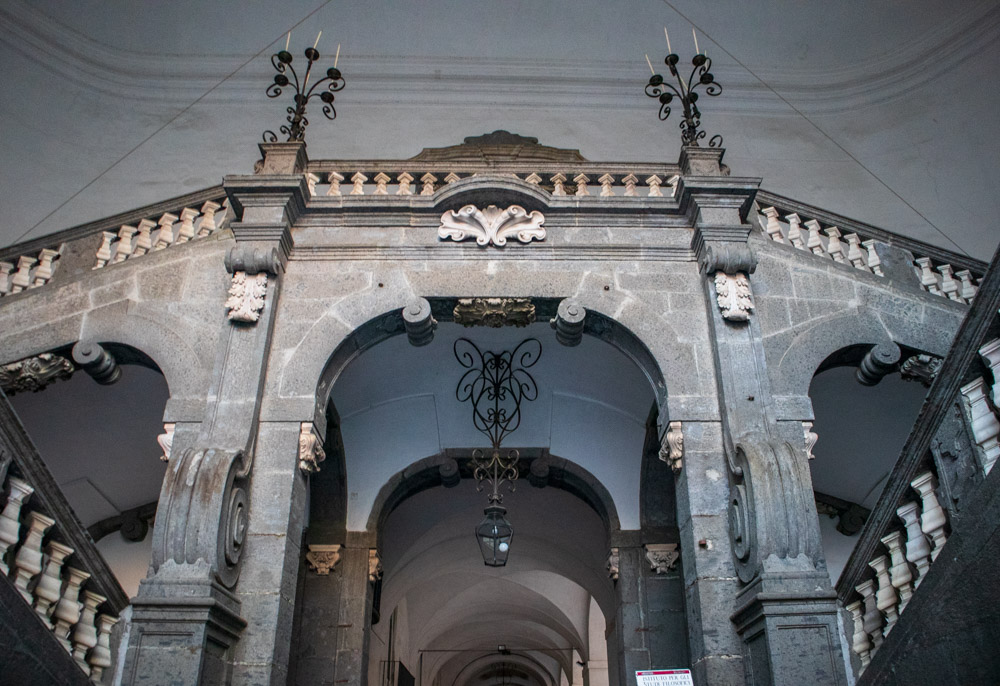
Access to the Bourbon Tunnel
Like almost all historical Neapolitan buildings, Palazzo Serra di Cassano was built predominantly with tufa excavated from underground. The external structure corresponds to an underground void of the same volume because tuff is a very resistant stone that, when extracted to make building blocks, does not create stability problems for the area underneath.
Over the years, the underground voids left by the extraction of tuff have been used in various ways, such as air-raid shelters, wells and cisterns. In the Palazzo Serra di Cassano courtyard, a well is connected to the cistern visible during the tour.
Access to the Bourbon Tunnel is through the foundations of the building where Palazzo Serra di Cassano hosted its carpentry shop, which today displays works of art and underground findings.
The air-raid shelter in World War II
The Palazzo Serra di Cassano has basement rooms that lead to an air-raid shelter in the Bourbon Tunnel. The tour guide sounds a manually operated air-raid siren before leading down the 115 steps to the shelter. During the tour, visitors can see personal items such as children’s shoes and perfume bottles that illustrate what life was like in the shelter during air raids.
The perfume bottles found in the Bourbon Tunnel are not just decorative items but remind us of the efforts made to combat the terrible smell of the overcrowded air raid shelter with open latrines. Despite the vastness of the Bourbon Tunnel and its high ceilings, at least 2,600 people found shelter here during both Allied and German bombing raids. Some sources suggest that up to 10,000 Neapolitans found refuge in the Bourbon Tunnel during the war. The people who lived in the shelter have numerous stories and anecdotes, including the birth of a baby girl amidst the bombings. Walking through the corridors, you can still see remnants of the past, such as electric cables and telephone lines used by the soldiers, with emergency contact numbers scribbled on the walls.
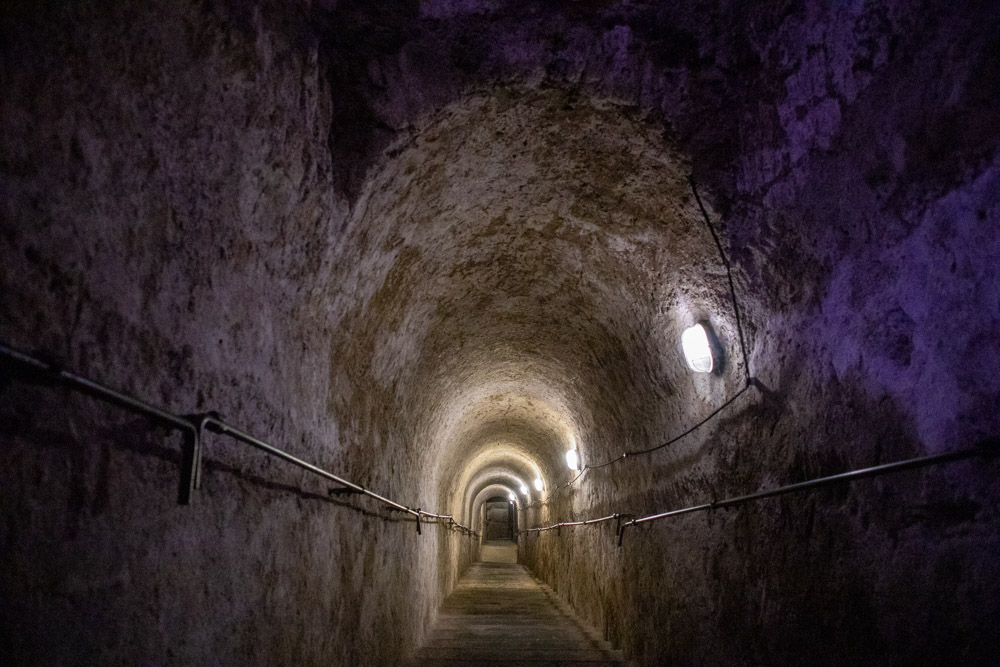
The cistern and tuff quarries of the Bourbon Tunnel
The Vie Memorie tour takes you through the Bourbon Tunnel, partly constructed by reusing the existing tuff quarries. As you journey deeper into the tunnel, the ceilings of Napoli Sotterranea get higher. The skilled artisans who worked in this area used ropes to lower themselves into the holes and detach the tuff blocks by hand.
Compared to other underground cities in Italy and Europe, such as the Pietro Micca Museum in Turin, the underground spaces in Naples are huge. You must see the Bourbon Tunnel in person to fully appreciate this fact. The ceilings of the Napoli Sotterranea are like reverse funnels, which is astonishing given that these voids were created centuries ago by hand, without machinery.
The tuff quarries in Naples have also been used as water cisterns. The Via delle Memorie tour takes you through one of these cisterns, used to collect water from the well in the courtyard of Palazzo Serra di Cassano. Today, the Associazione Culturale Borbonica Sotterranea hosts spectacular events in the cistern room.
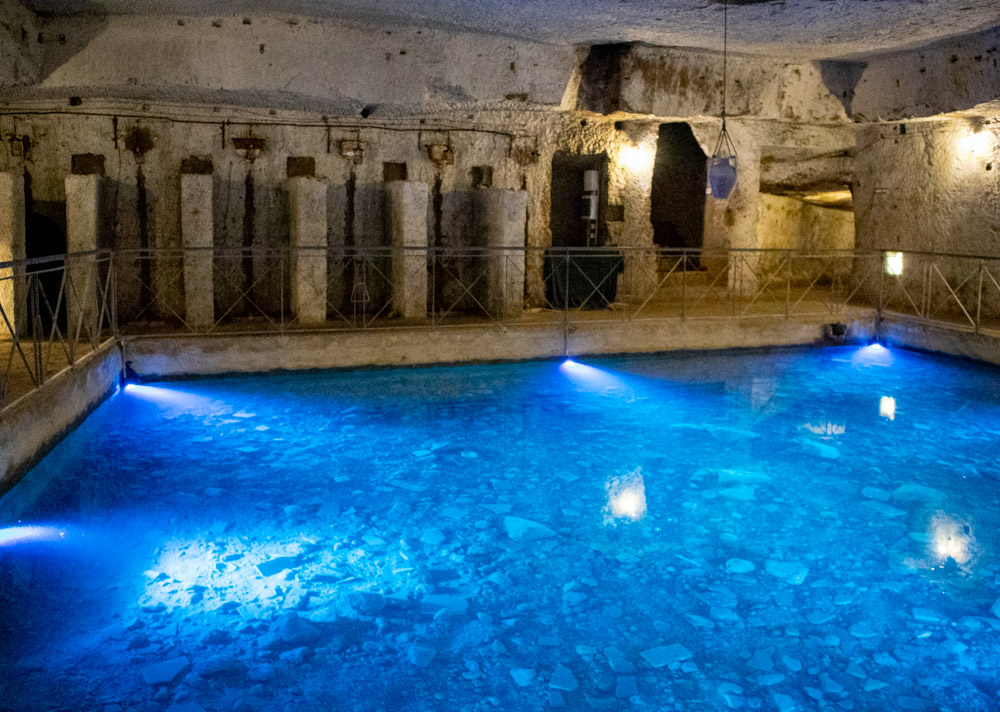
The Naples Municipal Court Depot
The Bourbon Tunnel’s Via delle Memorie route ends in the Deposito Giudiziale Comunale (Municipal Court Depot), an area used to store the vehicles seized after the war. The motorbikes and cars found here tell of the creativity of the Neapolitans, who developed or built means of transport from scratch from engines and body parts.
The Municipal Court Depot is definitely the most scenic part of the Bourbon Tunnel. Even if you don’t know about engines and can’t recognise fakes from originals, the guide tells you how most of the cars seized, now recovered and exhibited, are the work of Neapolitan inventiveness.
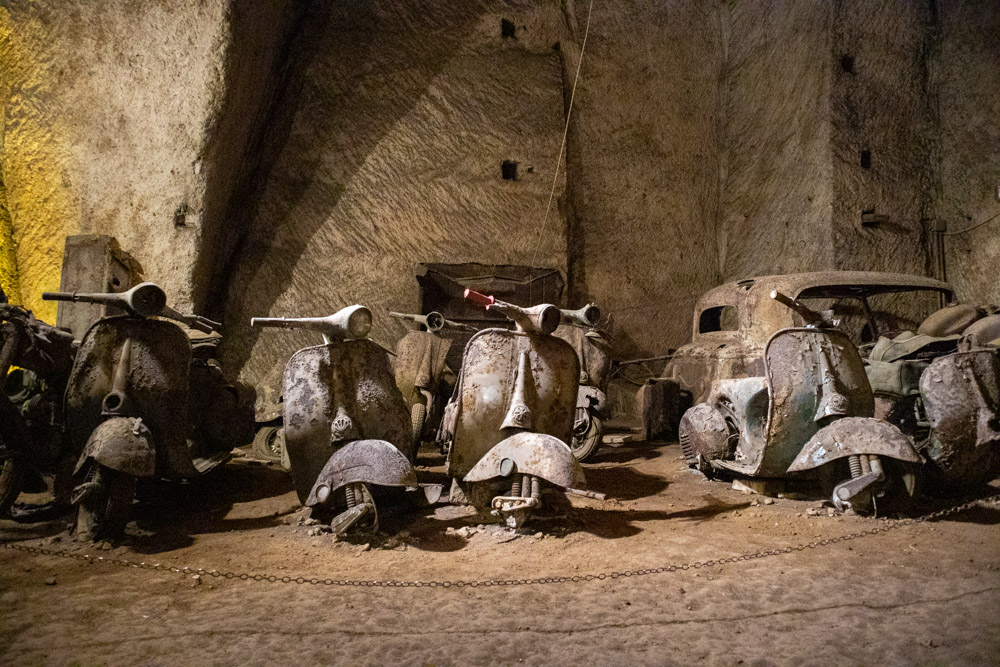
The exit on the seafront
After exploring the Bourbon Tunnel, you’ll come across a collection of found objects for sale. The proceeds from the sales go towards restoring the tunnels and funding the activities of the Bourbon Underground Cultural Association. This shop is unique in that it offers authentic World War II memorabilia, such as German army motorbike helmets and goggles, as well as telephones used by British troops.
The guided tour concludes at the Morelli car park exit, close to Naples’s seafront and the Chiaia district. As you go through the Bourbon Tunnel, you may not realise that you are descending towards the sea. Exiting the tunnel may leave you feeling disoriented.
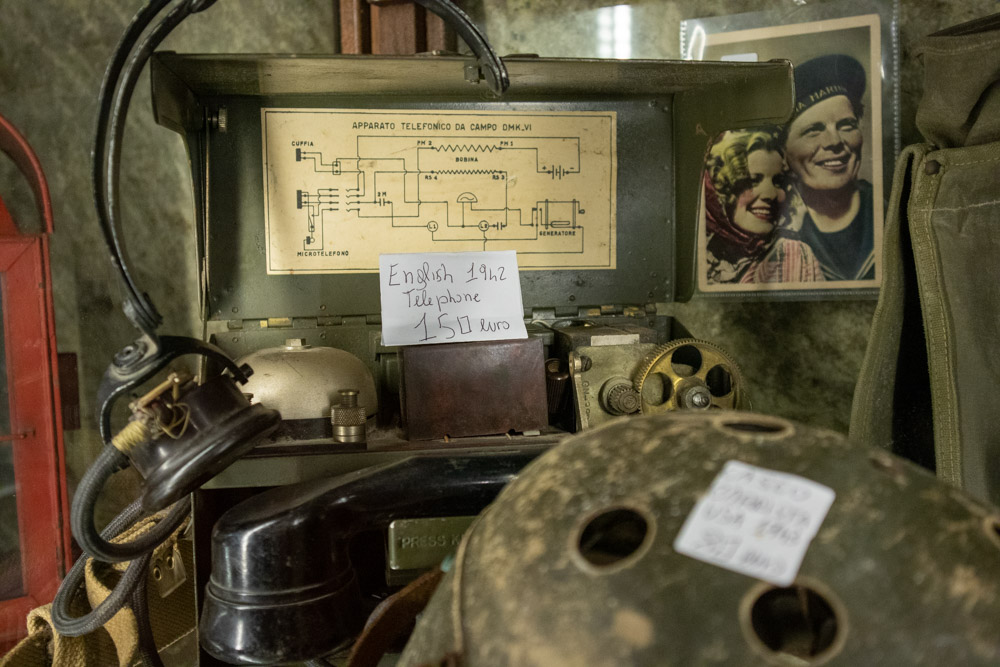
Practical information for visiting the Bourbon Tunnel
The Bourbon Tunnel is one of the tours to explore the Naples Underground. It is unique because it takes you inside a Bourbon engineering work. The Via delle Memorie tour is a great way to discover the city from a different perspective.
The Bourbon Tunnel has been restored to its original state, including the extensive tunnels and tuff quarries. However, the tunnels are not fully accessible to everyone. There are stairs with many steps, and to reach the air-raid shelter alone, you have to climb 115 of them. While it’s a wonderful experience, it can be challenging for small children who no longer fit in a baby carrier or for people with reduced mobility.
Ticket prices and availability for the Bourbon Tunnel
Tickets for the guided tour of the Bourbon Tunnel start at €10 per person, and children up to 10 years old get in free. Visits must be booked in advance, as tours only begin with confirmed participants.
Tours of the Bourbon Tunnel are generally from Friday to Sunday and on public holidays. One tour is in the morning and one in the afternoon. To organise and book your tickets in advance to secure a place on the guided tour that interests you, scroll through the dates on the interactive calendar below.
Meeting points of the Bourbon Tunnel tours
Guided tours of the Bourbon Tunnel start from two different entrances. One entry is in Via Monte di Dio, at Palazzo Serra di Cassano, while the other is in Vico del Grottone, where the Standard Route usually starts. The two entrances are about ten minutes’ walk apart. For this reason, I advise you to check carefully the meeting point on your ticket. If you arrive late, the tour may leave without you.
Galleria Borbonica
Via Monte di Dio, 14 / Vico del Grottone, 4
80132 Napoli
Where to stay in Naples
Naples boasts numerous accommodations, from hotels to seaside flats. With my frequent visits to Naples, I can suggest several options. For an authentic experience in the historic center, consider The Idyll Boutique Apartment in the Spanish Quarter. This charming flat features parquet floors and a fully equipped kitchen, conveniently close to major attractions. Alternatively, the upscale Relais Della Porta, situated on Via Toledo, places you a short distance from landmarks like the San Carlo Theatre. Last but not least, the Santa Chiara Boutique Hotel, located near the Dante metro stop, offers a continental or Italian breakfast to start your day.
One trip among underground churches, catacombs and tunnels is not enough to discover the lower level of the Neapolitan city. The Bourbon Tunnel tour is definitely one of the tours not to be missed in Naples. It is perfect for those who want a unique experience between history and architecture. Comment if you already know the Bourbon Tunnel.
